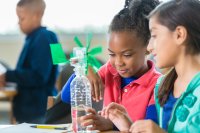4 Ways to Develop Creativity in Students
Creativity is a valuable skill, and there are common strategies teachers can use to help students develop it.
Your content has been saved!
Go to My Saved Content.Creativity is the most difficult thinking skill to acquire, and also the most sought-after. We value it in our music, entertainment, technology, and other aspects of our existence. We appreciate and yearn for it because it enriches our understanding and can make life easier.
Creativity always starts with imagination, and history shows that many things we imagine are later actually created. Gene Roddenberry imagined the Star Trek flip communicators in 1966, and Motorola produced them in 1996. In the mid 1800s, Augusta Ada King envisioned a language for computing machines that didn’t even exist; today she is honored as the founder of modern programing languages.
When Benjamin Bloom identified what he called the taxonomy of the cognitive domain, he ranked synthesis (creativity) as one of the most difficult skills to master because a person has to use all of the other cognitive skills in the creative process. Since, according to Bloom, creating is the highest order of thinking, it should be in the forefront of all learning environments and an end goal. When students create what they imagine, they’re in the driver’s seat.
Creativity in the Classroom
When designing learning experiences, teachers can plan and frame curriculum and provide tools that give students options, voice, and choice in order to enable them to be creative. In my work in schools, I’ve found four things that successful teachers do to develop creativity in their students.
1. Set up learning activities that allow students to explore their creativity in relevant, interesting, and worthwhile ways. Classroom example: Fourth-grade students are presented with a sample of rocks. They are to devise tests to determine what kind of rocks they have based on the definitions they’ve studied. Students find their own ways to determine differences in hardness, color, and shapes.
Another classroom example: A kindergarten class creates a new illustrated book each week that celebrates a different member of the class or an adult at the school. Each book is full of pages drawn by each student. They have the full liberty of depicting what the person likes and how they perceive him or her.
2. Value creativity and celebrate and reward it. Classroom example: Third-grade students are learning about polygons and to see if they know the concept, the teacher takes them outside and gives each student a sidewalk chalk. Each student is given the task of drawing several examples of polygons on the driveway.
Once the students have accomplished this, the teacher tells the students to transform those shapes into something they love. The students want to show everyone their geometric-based kittens, robots, and dragons and then have an opportunity to explain to the whole class why they liked them.
3. Teach students the other skills they need to be creative. Classroom example: A second-grade class is learning about the concept of freezing. The teacher asks one question to get them started, “Does only water freeze?” The students then design an experiment to determine what other things freeze. The limit is that they can only use what they have in the classroom at the time.
The students come up with a list of things that they will leave outside to see if they freeze: water, juice, vinegar, glue, glass cleaner, toothpaste, and paper. Some suggestions they decide are already solids and shouldn’t go outside: pencils, erasers, and books (but somehow paper stays on the test list). The next day, they discuss their findings and have engaging conversations about why the paper is stiff and the vinegar has not frozen.
The initial discussion among students about what might freeze fosters skills such as advocating for one’s ideas and compromising. The follow-up discussion encourages deductive reasoning and active listening.
4. Remove constraints for creativity and give the students space and a framework in which they can be creative. Classroom example: A sixth-grade class produces Halloween costume plays. In order to wear costumes to school, the students have to write a play that incorporates each of their characters into a plot and then present the play. For instance, they have to come up with how a giant soda can and the superhero Wonder Woman will interact. The students love the challenge.
We Learn by Doing
Imagination and creativity are the traits that fuel the future. Both serve to inspire students and should be integrated into every part of learning. In planning and designing learning for students, this we know: Teaching students how to think is more important than teaching students what to think.
